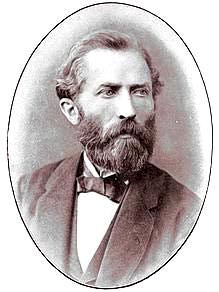Anton de Bary
Heinrich Anton de Bary (26 January 1831 – 19 January 1888) was a German surgeon, botanist, microbiologist, and mycologist (fungal systematics and physiology).
He is considered a founding father of plant pathology (phytopathology) as well as the founder of modern mycology. His extensive and careful studies of the life history of fungi and contribution to the understanding of algae and higher plants were landmarks of biology.[1][2]
Lichen
De Bary studied the formation of lichens, the association between a fungus and an alga. He traced the stages through which they grew and reproduced and the adaptations which enabled them to survive drought and winter. He coined the word 'symbiosis' in 1879 in his monograph as "the living together of unlike organisms".[3] He carefully studied the morphology of moulds, yeasts, and fungi and he established mycology as an independent science.[4]
Slime moulds
de Bary was one of the first people to do research on slime moulds (Myxomycetes). He published a key paper in 1859, and later a book on the subject.[5][6]
Anton De Bary Media
Anton de Bary (c. 1880) surrounded by students in a photo studio with a coulisse of the Strasbourg Cathedral in the backdrop.
References
- ↑ Large E.C. 1940, 1962. The advance of the fungi. New York.
- ↑ Martin G.W. 1958. The contribution of de Bary to our knowledge of the Myxomycetes. Proceedings of the Iowa Academy of Science 65, 122–127.
- ↑ de Bary A. 1879. Die Erscheinung der Symbiose. Strasbourg.
- ↑ McDougall W.B. 1918. The classification of symbiotic phenomena. Plant World 21, 250–256.
- ↑ de Bary A. 1887. Comparative morphology and biology of the Fungi, Mycetozoa and Bacteria. Oxford, transl. Henry E F. Garnsey and Isaac Bayley Balfour.
- ↑ Hoppe T & Kutschera U. 2010. In the shadow of Darwin: Anton de Bary's origin of myxomycetology and a molecular phylogeny of the plasmodial slime molds Theory Biosci. 129 (1):15-23. .

